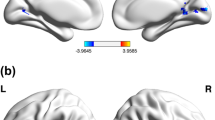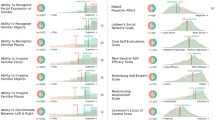Abstract
In everyday life, our sensory system is bombarded with visual input and we rely upon attention to select only those inputs that are relevant to behavioural goals. Typically, humans can shift their attention from one visual field to the other with little cost to perception. In cases of ‘unilateral neglect’, however, there is a persistent bias of spatial attention towards the same side as the damaged cerebral hemisphere. We used a visual orienting task to examine the influence of functional polymorphisms of the dopamine transporter gene (DAT1) on individual differences in spatial attention in normally developing children. DAT1 genotype significantly influenced spatial bias. Healthy children who were homozygous for alleles that influence the expression of dopamine transporters in the brain displayed inattention for left-sided stimuli, whereas heterozygotes did not. Our data provide the first evidence in healthy individuals of a genetically mediated bias in spatial attention that is related to dopamine signalling.
This is a preview of subscription content, access via your institution
Access options
Subscribe to this journal
Receive 12 print issues and online access
$259.00 per year
only $21.58 per issue
Buy this article
- Purchase on Springer Link
- Instant access to full article PDF
Prices may be subject to local taxes which are calculated during checkout


Similar content being viewed by others
References
Mesulam M-M . A cortical network for directed attention and unilateral neglect. Ann Neurol 1981; 10: 309–325.
Corbetta M, Shulman GL . Control of goal-directed and stimulus-driven attention in the brain. Nat Rev Neurosci 2002; 3: 201–215.
Robertson IH, Mattingley JB, Rorden C, Driver J . Phasic alerting of neglect patients overcomes their spatial deficit in visual awareness. Nature 1998; 395: 169–172.
Maruff P, Hay D, Malone V, Currie J . Asymmetries of covert attention in schizophrenia. Neuropsychologia 1995; 33: 1205–1233.
Sheppard DM, Bradshaw JL, Mattingley JB, Lee P . Effects of stimulant medication on the lateralisation of line bisection judgements of children with attention deficit hyperactivity disorder. J Neurol Neurosurg Psychiatry 1999; 66: 57–63.
Beane M, Marrocco RT . Norepinephrine and acetylcholine mediation of the components of reflexive attention: implications for attention deficit disorders. Prog Neurobiol 2004; 74: 167–181.
Posner MI, Peterson SE . The attention system of the human brain. Ann Rev Neurosci 1990; 13: 35–42.
Witte EA, Davidson MC, Marrocco RT . Effects of altering brain cholinergic activity on covert orienting of attention: comparison of monkey and human performance. Psychopharmacology (Berl) 1997; 132: 324–334.
Witte EA, Marrocco RT . Alteration of brain noradrenergic activity in rhesus monkeys affects the alerting component of covert orienting. Psychopharmacology (Berl) 1997; 132: 315–323.
Iversen SD . Behavioural effects of manipulation of basal ganglia neurotransmitters. CIBA Found Symp 1984; 107: 183–200.
Fleet WS, Valenstein E, Watson RT, Heilman KM . Dopamine agonist therapy for neglect in humans. Neurology 1987; 37: 1765–1770.
Grujic Z, Mapstone M, Gitelman DR, Johnson N, Weintraub S, Hays A et al. Dopamine agonists reorient visual exploration away from the neglected hemispace. Neurology 1998; 51: 1395–1398.
Coull JT, Nobre AC, Frith CD . The noradrenergic alpha2 agonist clonidine modulates behavioural and neuroanatomical correlates of human attentional orienting and alerting. Cereb Cortex 2001; 11: 73–84.
Volkow ND, Wang GJ, Fowler JS, Gatley SJ, Logan J, Ding YS et al. Dopamine transporter occupancies in the human brain induced by therapeutic doses of oral methylphenidate. Am J Psychiatry 1998; 155: 1325–1331.
Stins JF, Sonneville LM, Groot AS, Polderman TC, Baal CG, Boomsma DI . Heritability of selective attention and working memory in preschoolers. Behav Genet 2005; 35: 407–416.
Myles-Worsley M, Coon H . Genetic and developmental factors in spontaneous selective attention: a study of normal twins. Psychiatry Res 1997; 71: 163–174.
Greenwood PM, Fossella JA, Parasuraman R . Specificity of the effect of a nicotinic receptor polymorphism on individual differences in visuospatial attention. J Cogn Neurosci 2005; 17: 1611–1620.
Parasuraman R, Greenwood P, Kumar R, Fossella J . Beyond heritability: neurotransmitter genes differentially modulate visuospatial attention and working memory. Psychol Sci 2005; 16: 200–207.
Madras BK, Miller GM, Fischman AJ . The dopamine transporter and attention-deficit/hyperactivity disorder. Biol Psychiatry 2005; 57: 1397–1409.
Lewis DA, Melchitzky DS, Sesack SR, Whitehead RE, Auh S, Sampson A . Dopamine transporter immunoreactivity in monkey cerebral cortex: regional, laminar, and ultrastructural localization. J Comp Neurol 2001; 432: 119–136.
Cook EH, Stein MA, Krasowski MD, Cox NJ, Olkon DM, Kieffer JE et al. Association of attention-deficit disorder and the dopamine transporter gene. Am J Hum Genet 1995; 56: 993–998.
Brookes KJ, Mill J, Guindalini C, Curran S, Xu X, Knight J et al. A common haplotype of the dopamine transporter gene associated with attention-deficit/hyperactivity disorder and interacting with maternal use of alcohol during pregnancy. Arch Gen Psychiatry 2006; 63: 74–81.
Bellgrove MA, Gill M, Hawi Z, Kirley A, Robertson IH . Dissecting the attention deficit hyperactivity disorder (ADHD) phenotype: sustained attention, response variability and spatial attentional asymmetries in relation to dopamine transporter (DAT1) genotype. Neuropsychologia 2005; 43: 1847–1857.
Bellgrove MA, Hawi Z, Kirley A, Fitzgerald M, Gill M, Robertson IH . Association between dopamine transporter (DAT1) genotype, left-sided inattention, and an enhanced response to methylphenidate in attention-deficit hyperactivity disorder. Neuropsychopharmacol 2005; 30: 2290–2297.
Fuke S, Suo S, Takahashi N, Koike H, Sasagawa N, Ishiura S . The VNTR polymorphism of the human dopamine transporter (DAT1) gene affects gene expression. Pharmacogenomics J 2001; 1: 152–156.
VanNess SH, Owens MJ, Kilts CD . The variable number of tandem repeats element in DAT1 regulates in vitro dopamine transporter density. BMC Genet 2005; 6: 55.
Heinz A, Goldman D, Jones DW, Palmour R, Hommer D, Gorey JG et al. Genotype influences in vivo dopamine transporter availability in human striatum. Neuropsychopharmacol 2000; 22: 133–139.
Cheon KA, Ryu YH, Kim JW, Cho DY . The homozygosity for 10-repeat allele at dopamine transporter gene and dopamine transporter density in Korean children with attention deficit hyperactivity disorder: relating to treatment response to methylphenidate. Eur Neuropsychopharmacol 2005; 15: 95–101.
Guindalini C, Howard M, Haddley K, Laranjeira R, Collier D, Ammar N et al. A dopamine transporter gene functional variant associated with cocaine abuse in a Brazilian sample. Proc Natl Acad Sci USA 2006; 103: 4552–4557.
Conners CK . Rating scales in attention deficit hyperactivity disorder: use in assessment and treatment monitoring. J Clin Psychiatry 1998; 59: 24–30.
Posner M, Walker J, Friedrich FJ, Rafal R . Effects of parietal injury on covert orienting of attention. J Neurosci 1984; 4: 1863–1874.
Robertson IH, Manly T, Beschin N, Daini R, Haeske-Dewick H, Homberg V et al. Auditory sustained attention is a marker of unilateral spatial neglect. Neuropsychologia 1997; 35: 1527–1532.
Manly T, Dobler VB, Dodds CM, George MA . Rightward shift in spatial awareness with declining alertness. Neuropsychologia 2005; 43: 1721–1728.
Fossella J, Sommer T, Fan J, Wu Y, Swanson JM, Pfaff DW et al. Assessing the molecular genetics of attention networks. BMC Neurosci 2002; 3: 14.
Rueda MR, Rothbart MK, McCandliss BD, Saccomanno L, Posner MI . Training, maturation, and genetic influences on the development of executive attention. Proc Natl Acad Sci USA 2005; 102: 14931–14936.
Loo SK, Specter E, Smolen A, Hopfer C, Teale PD, Reite ML . Functional effects of the DAT1 polymorphism on EEG measures in ADHD. J Am Acad Child Adolesc Psychiatry 2003; 42: 986–993.
Gilbert DL, Wang Z, Sallee FR, Ridel KR, Merhar S, Zhang J et al. Dopamine transporter genotype influences the physiological response to medication in ADHD. Brain 2006; 129 (Part 8): 2038–2046.
Parasuraman R, Greenwood PM, Alexander GE . Alzheimer disease constricts the dynamic range of spatial attention in visual search. Neuropsychologia 2000; 38: 1126–1135.
Levy JA, Parasuraman R, Greenwood PM, Dukoff R, Sunderland T . Acetylcholine affects the spatial scale of attention: evidence from Alzheimer's disease. Neuropsychology 2000; 14: 288–298.
Mehta MA, Owen AM, Sahakian BJ, Mavaddat N, Pickard JD, Robbins TW . Methylphenidate enhances working memory by modulating discrete frontal and parietal lobe regions in the human brain. J Neurosci 2000; 20: RC65.
Nigg JT, Swanson JM, Hinshaw SP . Covert visual spatial attention in boys with attention deficit hyperactivity disorder: lateral effects, methylphenidate response, and results for parents. Neuropsychologia 1997; 35: 165–176.
Awh E, Jonides J . Overlapping mechanisms of attention and spatial working memory. Trends Cogn Sci 2001; 5: 119–126.
Stephens M, Donnelly P . A comparison of bayesian methods for haplotype reconstruction from population genotype data. Am J Hum Genet 2003; 73: 1162–1169.
Acknowledgements
This work was supported by grants from the Irish Health Research Board, Science Foundation Ireland, the Irish Higher Education Authority's Programme for Research in Third-Level Institutions and the Australian Academy of Science (CDC). MAB is supported by an Australian National Health and Medical Research Council Howard Florey Centenary Fellowship. CDC is a David Phillips Fellow of the BBSRC, UK. We thank Jason Mattingley and Rob Hester for helpful discussions.
Author information
Authors and Affiliations
Corresponding author
Rights and permissions
About this article
Cite this article
Bellgrove, M., Chambers, C., Johnson, K. et al. Dopaminergic genotype biases spatial attention in healthy children. Mol Psychiatry 12, 786–792 (2007). https://doi.org/10.1038/sj.mp.4002022
Received:
Revised:
Accepted:
Published:
Issue Date:
DOI: https://doi.org/10.1038/sj.mp.4002022
Keywords
This article is cited by
-
Dopamine influences attentional rate modulation in Macaque posterior parietal cortex
Scientific Reports (2022)
-
Genetic contributions to attentional response time slopes across repeated trials
BMC Neuroscience (2015)
-
Does Stroke Imaging Provide Insights into the Neural Basis of Cognition?
Current Neurology and Neuroscience Reports (2015)
-
Modulation of orbitofrontal response to amphetamine by a functional variant of DAT1 and in vitro confirmation
Molecular Psychiatry (2011)
-
Spatial Attentional Bias as a Marker of Genetic Risk, Symptom Severity, and Stimulant Response in ADHD
Neuropsychopharmacology (2008)



